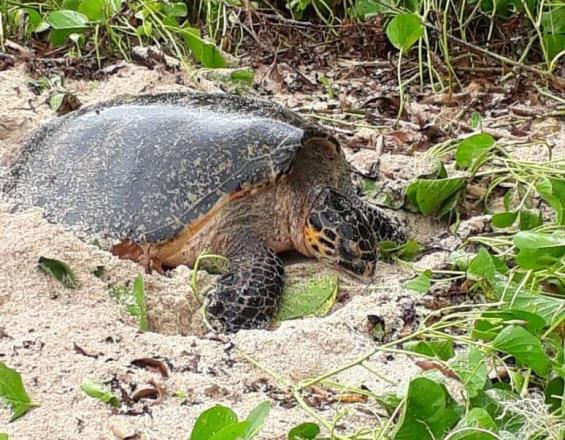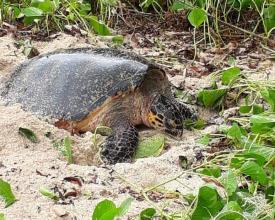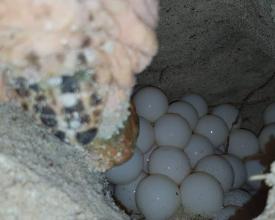Piloter des zones temporellement protégées pour la conservation des tortues dans les États insulaires : les leçons des Seychelles

La mise en place de zones protégées sur une base saisonnière permet de protéger les tortues et leur progéniture pendant la saison de nidification et d'éclosion. L'approche des zones protégées temporelles garantit que les tortues ne sont pas dérangées, blessées ou braconnées pendant ces périodes importantes.
Cette initiative se concentre sur la protection des tortues imbriquées, qui nichent de manière saisonnière, principalement sur les îles intérieures des Seychelles. Les principales zones de nidification au sud de Mahé, l'île la plus grande et la plus peuplée des Seychelles, ont été désignées pour une protection temporaire.
Les plages de nidification sont patrouillées régulièrement, avec un effort intensifié pendant la haute saison pour faciliter la protection de l'espèce à cette phase critique du cycle de vie, ainsi que l'enregistrement des données des tortues en train de nidifier. Les rencontres opportunistes avec les femelles en train de nidifier fournissent les données nécessaires à l'identification individuelle afin de mieux surveiller leurs comportements de nidification.
Contexte
Défis à relever
Les plages de nidification deviennent de plus en plus populaires, avec des visites fréquentes de touristes, de locaux qui pique-niquent et parfois campent sur les plages. Le bruit qui y est associé peut perturber les tortues nicheuses, les empêcher d'émerger et de pondre leurs œufs.
La replantation de la végétation sur certaines plages a également ses limites : les sites de replantation sont facilement accessibles aux visiteurs et, malheureusement, toute tentative de replantation s'est soldée par l'enlèvement délibéré des plantes ou des boutures, ou par leur piétinement lorsque les gens se rendent sur la plate-forme de la plage. L'ipomée (Ipomoea) est une très bonne plante pour la prévention de l'érosion du sable sur les plages de nidification. Cependant, elle est considérée comme un obstacle pour les tortues qui nichent, car elles s'emmêlent souvent dans la plante rampante.
La viande de tortue de mer est toujours vendue au marché noir et les tortues imbriquées sont plus accessibles, les femelles nichant souvent pendant la journée et étant l'espèce la plus commune nichant sur les îles intérieures.
Emplacement
Traiter
Résumé du processus
Suivi régulier et collecte de données : le personnel est formé pour effectuer un suivi qualitatif et quantitatif et collecter des données suffisantes et fiables pour soutenir le projet.
Participation de la communauté : la communauté est encouragée à participer à plusieurs activités, et même à se joindre aux patrouilles afin d'être associée aux efforts de conservation des tortues marines. Des ateliers sont également organisés pour améliorer les connaissances des habitants sur les tortues de mer et les écoles sont régulièrement contactées pour organiser des activités telles que des présentations afin d'éduquer la jeune génération.
Dossier de nomination : il s'agit de définir clairement l'intérêt et la nécessité de créer des zones de protection temporelle pour les tortues de mer dans les zones désignées.
Plans de gestion et protocole d'accord : pour expliquer l'objectif à long terme des ZPT et la manière dont elles seront gérées et deviendront autonomes, avec un protocole d'accord clair qui définit la cogestion.
Blocs de construction
Nomination des zones protégées temporelles potentielles
La désignation d'aires protégées temporelles est apparue après la collecte continue de données sur les plages de nidification, qui ont mis en évidence des plages spécifiques comme étant les principaux sites de nidification des tortues imbriquées sur l'île principale de Mahé.
Pendant plus de 15 ans, des patrouilles ont été effectuées tout au long de l'année, la fréquence dépendant de la haute et de la basse saison de nidification des tortues. La procédure consiste à parcourir physiquement les plages sur toute leur longueur afin d'identifier les activités des tortues marines. Des drones sont également utilisés pour survoler la zone de patrouille, afin de faciliter la tâche. Les données générées par les patrouilles sont le nombre de traces/émergences sur les plages, un ensemble de traces ascendantes et descendantes par tortue. Chaque ensemble est ensuite lié à une émergence, qui indique si la tortue a réussi à nicher ou non. Les nids réussis sont marqués, géolocalisés et surveillés tout au long de l'incubation jusqu'à ce qu'une éclosion réussie soit observée. Lorsqu'ils rencontrent des tortues, les patrouilleurs suivent l'ensemble du processus de nidification afin d'assurer une protection supplémentaire et de veiller à ce que les femelles qui nichent retournent à la mer en toute sécurité.
Facteurs favorables
Les ressources humaines sont de la plus haute importance, la collecte de données et les activités de surveillance ne seraient pas possibles sans les patrouilleurs.
Leçon apprise
Il faut garder à l'esprit que la communauté est une partie prenante importante - sans son soutien, le projet peut échouer. Il est indispensable d'établir de bonnes relations avec toutes les parties prenantes et de veiller à ce que la communauté soit informée des avantages qu'elle retire de son soutien au projet.
Ressources
Éducation et sensibilisation au sein de la communauté locale
La communauté locale est déjà bien consciente de l'existence des plages de nidification et du travail de surveillance des tortues de mer effectué par la MCSS. Cependant, peu de gens connaissent la situation réelle des tortues de mer au niveau local et mondial, et peu comprennent la nécessité de conserver ces espèces. Des activités d'éducation et de sensibilisation sont souvent organisées dans le cadre d'activités communautaires et surtout d'activités avec les différents écoliers de Mahé, les zones sud et est étant une priorité. De plus, l'organisation participe à des événements nationaux afin de présenter notre travail en faveur de la conservation des tortues marines. Nous travaillons également en partenariat avec certains hôtels dont les propriétés bordent certaines des plages de nidification.
Facteurs favorables
Les transports facilitent les patrouilles. Les plages de nidification sont très éloignées à pied, ce qui affecte la gestion du temps et la capacité à s'occuper rapidement des tortues nicheuses lorsque les habitants les alertent.
Il est également très important de disposer d'un équipement facilitant la collecte de données précises, afin de pouvoir présenter des enregistrements de données. Un outil de collecte de données spatiales GPS très précis permet à l'équipe de patrouille de collecter des données par le biais du logiciel Cybertracker et des applications que nous avons conçues en fonction des données à collecter.
Leçon apprise
Les jeunes sont l'avenir, et il est très bénéfique d'utiliser la bonne approche pour leur apprendre à devenir eux-mêmes des défenseurs de la cause. Parfois, le message devient plus réaliste lorsque les enfants enseignent eux-mêmes à leurs parents et contribuent à changer leur mentalité et leur point de vue sur la protection des tortues de mer.
Ressources
Impacts
Les incidents liés au braconnage des tortues ont considérablement diminué grâce aux patrouilles fréquentes de l'équipe de surveillance. La présence de patrouilleurs sur les plages de nidification réduit les activités de braconnage.
On a également observé un plus grand nombre de nidifications réussies, d'autant plus que le public est sensibilisé et respecte le code de conduite des observateurs de tortues, qui définit les choses à faire et à ne pas faire en cas de rencontre avec des tortues en période de nidification et des nouveau-nés.
La préparation des plateformes de nidification avant la saison de nidification et l'élimination des débris naturels et anthropogéniques qui constituent des obstacles pour les tortues aident ces dernières à nicher avec succès, ce qui se traduit par une augmentation du nombre de nids recensés.
Les zones protégées temporelles peuvent être mieux acceptées par le public car elles n'imposent des restrictions qu'à certaines périodes de l'année. La protection temporelle fait prendre conscience de la valeur de la zone pour d'autres espèces et de l'impact de la protection de ces zones sur la réussite de la nidification des tortues. Tous ces aspects peuvent être renforcés par des ateliers publics et expliqués lors de visites guidées sur les sites et sur des panneaux d'information.
Les tortues sont des espèces emblématiques pour les Seychellois, qui figurent même sur la monnaie nationale. Elles sont appréciées pour leur beauté et le rôle important qu'elles jouent dans notre biodiversité. Par conséquent, les tortues marines contribuent à l'économie des Seychelles, en promouvant la valeur de notre pays.
Bénéficiaires
Les espèces de tortues marines qui nichent en sont les premières bénéficiaires.
Indirectement, la communauté locale en bénéficie également, car les tortues sont importantes d'un point de vue culturel et économique, grâce à leur valeur pour le tourisme.
Objectifs de développement durable
Histoire
La Marine Conservation Society Seychelles collecte des données sur les activités des tortues marines depuis plus de 15 ans. L'organisation plaide fortement en faveur de la protection des tortues de mer et de la mise en place de zones temporelles protégées pour la nidification des tortues de mer. Le travail de l'organisation a fourni suffisamment de données pour indiquer que le sud de Mahé est le principal site de nidification, en particulier pour les tortues imbriquées, et qu'il justifie donc le statut de zone temporelle protégée. Vanessa Didion, responsable du projet MCSS, note :
"J'ai commencé comme assistante de recherche sur le terrain et, grâce à mon enthousiasme et à mon dévouement, j'ai été promue à mon poste actuel de chef de projet pour le projet des zones temporelles protégées, qui préconise la conservation des tortues marines aux Seychelles. Mon intérêt profond pour la conservation des tortues de mer s'est manifesté dès ma première rencontre avec une tortue en train de nicher ; à partir de ce jour, j'ai su que j'avais trouvé le bon emploi et que je faisais quelque chose de vraiment utile.
Mon expérience personnelle en tant qu'enseignante m'a permis d'acquérir les qualités nécessaires pour transmettre aux autres les connaissances sur les tortues de mer et promouvoir une sensibilisation efficace au projet dans son ensemble. Travaillant depuis longtemps dans la communauté, je suis également bien connue et j'ai déjà de bonnes relations avec les habitants, ce qui est très utile et facilite un grand nombre d'activités de sensibilisation que j'entreprends.



